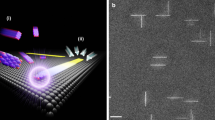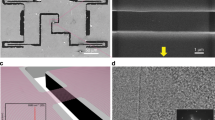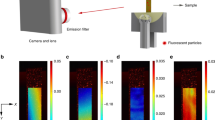Abstract
Graphene is a fascinating material with unique properties, such as extreme mechanical strength, ultrahigh electrical and thermal conductivities and remarkable transparency. Further reduction in the dimensionality of graphene in the form of graphene quantum dots and graphene nanoribbons has compensated for the lack of a bandgap in the extended 2D material. These nanoscale graphenes exhibit finite bandgaps because of quantum confinement, making them attractive as next-generation semiconductors. Numerous fabrication methods for various types of graphenes have been developed, which can generally be categorized into ‘top-down’ and ‘bottom-up’ procedures. These methods afford, on different production scales, a wide range of graphene structures of different sizes, shapes and quality (defect density, edge roughness and so on). Atomically precise syntheses are indispensable for fundamental research and future technological development, but the projection of the existing methods to cost-effective bulk-scale fabrication techniques is required for upcoming industrial applications of graphenes.
This is a preview of subscription content, access via your institution
Access options
Access Nature and 54 other Nature Portfolio journals
Get Nature+, our best-value online-access subscription
$29.99 / 30 days
cancel any time
Subscribe to this journal
Receive 12 digital issues and online access to articles
$119.00 per year
only $9.92 per issue
Buy this article
- Purchase on Springer Link
- Instant access to full article PDF
Prices may be subject to local taxes which are calculated during checkout




Similar content being viewed by others
References
Novoselov, K. S. et al. Electric field effect in atomically thin carbon films. Science 306, 666–669 (2004).
Geim, A. K. & Novoselov, K. S. The rise of graphene. Nat. Mater. 6, 183–191 (2007).
Geim, A. K. Graphene: status and prospects. Science 324, 1530–1534 (2009).
Novoselov, K. S. et al. A roadmap for graphene. Nature 490, 192–200 (2012).
Ferrari, A. C. et al. Science and technology roadmap for graphene, related two-dimensional crystals, and hybrid systems. Nanoscale 7, 4598–4810 (2015).
Ren, W. & Cheng, H.-M. The global growth of graphene. Nat. Nano. 9, 726–730 (2014).
Xiao, X., Li, Y. & Liu, Z. Graphene commercialization. Nat. Mater. 15, 697–698 (2016).
Bianco, A. et al. All in the graphene family — a recommended nomenclature for two-dimensional carbon materials. Carbon 65, 1–6 (2013).
Morozov, S. V. et al. Giant intrinsic carrier mobilities in graphene and its bilayer. Phys. Rev. Lett. 100, 016602 (2008).
Park, S. & Ruoff, R. S. Chemical methods for the production of graphenes. Nat. Nano. 4, 217–224 (2009).
Chua, C. K. & Pumera, M. Chemical reduction of graphene oxide: a synthetic chemistry viewpoint. Chem. Soc. Rev. 43, 291–312 (2014).
Eigler, S. et al. Wet chemical synthesis of graphene. Adv. Mater. 25, 3583–3587 (2013).
Butz, B., Dolle, C., Halbig, C. E., Spiecker, E. & Eigler, S. Highly intact and pure oxo-functionalized graphene: synthesis and electron-beam-induced reduction. Angew. Chem. Int. Ed. 55, 15771–15774 (2016).
Hernandez, Y. et al. High-yield production of graphene by liquid-phase exfoliation of graphite. Nat. Nano. 3, 563–568 (2008).
Leon, V. et al. Few-layer graphenes from ball-milling of graphite with melamine. Chem. Commun. 47, 10936–10938 (2011).
Paton, K. R. et al. Scalable production of large quantities of defect-free few-layer graphene by shear exfoliation in liquids. Nat. Mater. 13, 624–630 (2014).
León, V., Rodriguez, A. M., Prieto, P., Prato, M. & Vázquez, E. Exfoliation of graphite with triazine derivatives under ball-milling conditions: preparation of few-layer graphene via selective noncovalent interactions. ACS Nano 8, 563–571 (2014).
Damm, C., Nacken, T. J. & Peukert, W. Quantitative evaluation of delamination of graphite by wet media milling. Carbon 81, 284–294 (2015).
Ciesielski, A. & Samori, P. Graphene via sonication assisted liquid-phase exfoliation. Chem. Soc. Rev. 43, 381–398 (2014).
Yang, S., Lohe, M. R., Müllen, K. & Feng, X. New-generation graphene from electrochemical approaches: production and applications. Adv. Mater. 28, 6213–6221 (2016).
Yang, S. et al. Organic radical-assisted electrochemical exfoliation for the scalable production of high-quality graphene. J. Am. Chem. Soc. 137, 13927–13932 (2015).
Yang, S. et al. Ultrafast delamination of graphite into high-quality graphene using alternating currents. Angew. Chem. Int. Ed. 56, 6669–6675 (2017).
Matsumoto, M., Saito, Y., Park, C., Fukushima, T. & Aida, T. Ultrahigh-throughput exfoliation of graphite into pristine ‘single-layer’ graphene using microwaves and molecularly engineered ionic liquids. Nat. Chem. 7, 730–736 (2015).
Voiry, D. et al. High-quality graphene via microwave reduction of solution-exfoliated graphene oxide. Science 353, 1413–1416 (2016).
de Heer, W. A. et al. Large area and structured epitaxial graphene produced by confinement controlled sublimation of silicon carbide. Proc. Natl Acad. Sci. USA 108, 16900–16905 (2011).
Lin, Y. M. et al. 100-GHz transistors from wafer-scale epitaxial graphene. Science 327, 662 (2010).
Li, X., Colombo, L. & Ruoff, R. S. Synthesis of graphene films on copper foils by chemical vapor deposition. Adv. Mater. 28, 6247–6252 (2016).
Li, X. et al. Large-area synthesis of high-quality and uniform graphene films on copper foils. Science 324, 1312 (2009).
Bae, S. et al. Roll-to-roll production of 30-inch graphene films for transparent electrodes. Nat. Nano. 5, 574–578 (2010).
Kobayashi, T. et al. Production of a 100-m-long high-quality graphene transparent conductive film by roll-to-roll chemical vapor deposition and transfer process. Appl. Phys. Lett. 102, 023112 (2013).
Strudwick, A. J. et al. Chemical vapor deposition of high quality graphene films from carbon dioxide atmospheres. ACS Nano 9, 31–42 (2015).
Yazyev, O. V. & Chen, Y. P. Polycrystalline graphene and other two-dimensional materials. Nat. Nano. 9, 755–767 (2014).
Geng, D., Wang, H. & Yu, G. Graphene single crystals: size and morphology engineering. Adv. Mater. 27, 2821–2837 (2015).
Hao, Y. et al. The role of surface oxygen in the growth of large single-crystal graphene on copper. Science 342, 720–723 (2013).
Wu, T. et al. Fast growth of inch-sized single-crystalline graphene from a controlled single nucleus on Cu-Ni alloys. Nat. Mater. 15, 43–47 (2016).
Lee, J.-H. et al. Wafer-scale growth of single-crystal monolayer graphene on reusable hydrogen-terminated germanium. Science 344, 286–289 (2014).
Yang, W. et al. Epitaxial growth of single-domain graphene on hexagonal boron nitride. Nat. Mater. 12, 792–797 (2013).
Wang, H. & Yu, G. Direct CVD graphene growth on semiconductors and dielectrics for transfer-free device fabrication. Adv. Mater. 28, 4956–4975 (2016).
Chen, X., Wu, B. & Liu, Y. Direct preparation of high quality graphene on dielectric substrates. Chem. Soc. Rev. 45, 2057–2074 (2016).
Ponomarenko, L. A. et al. Chaotic dirac billiard in graphene quantum dots. Science 320, 356–358 (2008).
Pan, D., Zhang, J., Li, Z. & Wu, M. Hydrothermal route for cutting graphene sheets into blue-luminescent graphene quantum dots. Adv. Mater. 22, 734–738 (2010).
Chua, C. K. et al. Synthesis of strongly fluorescent graphene quantum dots by cage-opening buckminsterfullerene. ACS Nano 9, 2548–2555 (2015).
Chen, G. et al. Rupturing C60 molecules into graphene-oxide-like quantum dots: structure, photoluminescence, and catalytic application. Small 11, 5296–5304 (2015).
Li, F., Kou, L., Chen, W., Wu, C. & Guo, T. Enhancing the short-circuit current and power conversion efficiency of polymer solar cells with graphene quantum dots derived from double-walled carbon nanotubes. NPG Asia Mater. 5, e60 (2013).
Shen, J., Zhu, Y., Yang, X. & Li, C. Graphene quantum dots: emergent nanolights for bioimaging, sensors, catalysis and photovoltaic devices. Chem. Commun. 48, 3686–3699 (2012).
Xu, W. & Lee, T.-W. Recent progress in fabrication techniques of graphene nanoribbons. Mater. Horiz. 3, 186–207 (2016).
Li, X., Wang, X., Zhang, L., Lee, S. & Dai, H. Chemically derived, ultrasmooth graphene nanoribbon semiconductors. Science 319, 1229–1232 (2008).
Wang, X. et al. Room-temperature all-semiconducting sub-10-nm graphene nanoribbon field-effect transistors. Phys. Rev. Lett. 100, 206803 (2008).
Tapaszto, L., Dobrik, G., Lambin, P. & Biro, L. P. Tailoring the atomic structure of graphene nanoribbons by scanning tunnelling microscope lithography. Nat. Nano. 3, 397–401 (2008).
Liang, X. & Wi, S. Transport characteristics of multichannel transistors made from densely aligned sub-10 nm half-pitch graphene nanoribbons. ACS Nano 6, 9700–9710 (2012).
Son, J. G. et al. Sub-10 nm graphene nanoribbon array field-effect transistors fabricated by block copolymer lithography. Adv. Mater. 25, 4723–4728 (2013).
Bai, J., Duan, X. & Huang, Y. Rational fabrication of graphene nanoribbons using a nanowire etch mask. Nano Lett. 9, 2083–2087 (2009).
Kosynkin, D. V. et al. Longitudinal unzipping of carbon nanotubes to form graphene nanoribbons. Nature 458, 872–876 (2009).
Jiao, L., Zhang, L., Wang, X., Diankov, G. & Dai, H. Narrow graphene nanoribbons from carbon nanotubes. Nature 458, 877–880 (2009).
Jiao, L., Wang, X., Diankov, G., Wang, H. & Dai, H. Facile synthesis of high-quality graphene nanoribbons. Nat. Nano. 5, 321–325 (2010).
Wu, J., Pisula, W. & Müllen, K. Graphenes as potential material for electronics. Chem. Rev. 107, 718–747 (2007).
Yan, X. Li, B. & Li, L.-s. Colloidal graphene quantum dots with well-defined structures. Acc. Chem. Res. 46, 2254–2262 (2013).
Konishi, A. et al. Synthesis and characterization of quarteranthene: elucidating the characteristics of the edge state of graphene nanoribbons at the molecular level. J. Am. Chem. Soc. 135, 1430–1437 (2013).
Paternò, G. M. et al. Synthesis of dibenzo[hi, st]ovalene and its amplified spontaneous emission in a polystyrene matrix. Angew. Chem. Int. Ed. 56, 6753–6757 (2017).
Wang, L. et al. Gram-scale synthesis of single-crystalline graphene quantum dots with superior optical properties. Nat. Commun. 5, 5357 (2014).
Yang, X. et al. Two-dimensional graphene nanoribbons. J. Am. Chem. Soc. 130, 4216–4217 (2008).
Schwab, M. G. et al. Structurally defined graphene nanoribbons with high lateral extension. J. Am. Chem. Soc. 134, 18169–18172 (2012).
Narita, A. et al. Synthesis of structurally well-defined and liquid-phase-processable graphene nanoribbons. Nat. Chem. 6, 126–132 (2014).
Konnerth, R. et al. Tuning the deposition of molecular graphene nanoribbons by surface functionalization. Nanoscale 7, 12807–12811 (2015).
Vo, T. H. et al. Large-scale solution synthesis of narrow graphene nanoribbons. Nat. Commun. 5, 3189 (2014).
Jordan, R. S. et al. Synthesis of graphene nanoribbons via the topochemical polymerization and subsequent aromatization of a diacetylene precursor. Chem 1, 78–90 (2016).
Yang, W., Lucotti, A., Tommasini, M. & Chalifoux, W. A. Bottom-up synthesis of soluble and narrow graphene nanoribbons using alkyne benzannulations. J. Am. Chem. Soc. 138, 9137–9144 (2016).
Daigle, M., Miao, D., Lucotti, A., Tommasini, M. & Morin, J.-F. Helically coiled graphene nanoribbons. Angew. Chem. Int. Ed. 56, 6213–6217 (2017).
Cai, J. et al. Atomically precise bottom-up fabrication of graphene nanoribbons. Nature 466, 470–473 (2010).
Talirz, L., Ruffieux, P. & Fasel, R. On-surface synthesis of atomically precise graphene nanoribbons. Adv. Mater. 28, 6222–6231 (2016).
Cloke, R. R. et al. Site-specific substitutional boron doping of semiconducting armchair graphene nanoribbons. J. Am. Chem. Soc. 137, 8872–8875 (2015).
Kawai, S. et al. Atomically controlled substitutional boron-doping of graphene nanoribbons. Nat. Commun. 6, 8098 (2015).
Zhang, Y. et al. Direct visualization of atomically precise nitrogen-doped graphene nanoribbons. Appl. Phys. Lett. 105, 023101 (2014).
Nguyen, G. D. et al. Bottom-up synthesis of N = 13 sulfur-doped graphene nanoribbons. J. Phys. Chem. C 120, 2684–2687 (2016).
Chen, Y.-C. et al. Molecular bandgap engineering of bottom-up synthesized graphene nanoribbon heterojunctions. Nat. Nano. 10, 156–160 (2015).
Cai, J. et al. Graphene nanoribbon heterojunctions. Nat. Nano. 9, 896–900 (2014).
Bennett, P. B. et al. Bottom-up graphene nanoribbon field-effect transistors. Appl. Phys. Lett. 103, 253114 (2013).
Llinas, J. P. et al. Short-channel field effect transistors with 9-atom and 13-atom wide graphene nanoribbons. Nat. Commun. 8, 633 (2017).
Ruffieux, P. et al. On-surface synthesis of graphene nanoribbons with zigzag edge topology. Nature 531, 489–492 (2016).
Fairbrother, A. et al. High vacuum synthesis and ambient stability of bottom-up graphene nanoribbons. Nanoscale 9, 2785–2792 (2017).
Sakaguchi, H. et al. Width-controlled sub-nanometer graphene nanoribbon films synthesized by radical-polymerized chemical vapor deposition. Adv. Mater. 26, 4134–4138 (2014).
Chen, Z. et al. Synthesis of graphene nanoribbons by ambient-pressure chemical vapor deposition and device integration. J. Am. Chem. Soc. 138, 15488–15496 (2016).
Sakaguchi, H., Song, S., Kojima, T. & Nakae, T. Homochiral polymerization-driven selective growth of graphene nanoribbons. Nat. Chem. 9, 57–63 (2017).
Sprinkle, M. et al. Scalable templated growth of graphene nanoribbons on SiC. Nat. Nano. 5, 727–731 (2010).
Kato, T. & Hatakeyama, R. Site- and alignment-controlled growth of graphene nanoribbons from nickel nanobars. Nat. Nano. 7, 651–656 (2012).
Safron, N. S., Kim, M., Gopalan, P. & Arnold, M. S. Barrier-guided growth of micro- and nano-structured graphene. Adv. Mater. 24, 1041–1045 (2012).
Subramaniam, D. et al. Wave-function mapping of graphene quantum dots with soft confinement. Phys. Rev. Lett. 108, 046801 (2012).
Talirz, L. et al. On-surface synthesis and characterization of 9-atom wide armchair graphene nanoribbons. ACS Nano 11, 1380–1388 (2017).
Acknowledgements
The authors acknowledge all of their distinguished collaborators and dedicated research associates, who enabled their achievements partly described in this article. They thank EU Projects GENIUS (ITN-264694), UPGRADE and MoQuaS, Graphene Flagship (No. CNECT-ICT-604391), European Research Council (ERC)-Adv.-Grant 267160 (NANOGRAPH), the Max Planck Society, the Office of Naval Research Basic Research Challenge (BRC) Program (molecular synthesis and characterization), Deutsche Forschungsgemeinschaft (DFG) Priority Programme SPP 1459 and the Alexander von Humboldt Foundation for financial support.
Author information
Authors and Affiliations
Contributions
X.-Y.W. researched the literature and published data for the article and produced the first draft together with A.N. All authors discussed the content and contributed to the review and editing of the manuscript before submission.
Corresponding authors
Ethics declarations
Competing interests
The authors declare no competing interests.
Rights and permissions
About this article
Cite this article
Wang, XY., Narita, A. & Müllen, K. Precision synthesis versus bulk-scale fabrication of graphenes. Nat Rev Chem 2, 0100 (2018). https://doi.org/10.1038/s41570-017-0100
Published:
DOI: https://doi.org/10.1038/s41570-017-0100
This article is cited by
-
Porphyrin-fused graphene nanoribbons
Nature Chemistry (2024)
-
Nano-engineered Solutions for Sustainable Environmental Cleanup
BioNanoScience (2024)
-
Zwitterionic Bergman cyclization triggered polymerization gives access to metal-graphene nanoribbons using a boron metal couple
Communications Chemistry (2023)
-
Graphene oxide classification and standardization
Scientific Reports (2023)
-
Staying alive
Nature Reviews Chemistry (2023)



